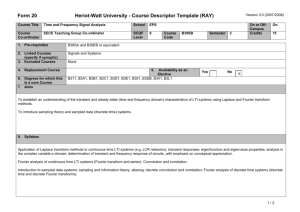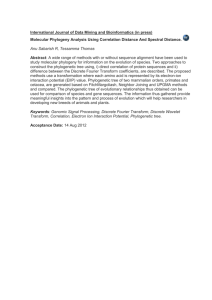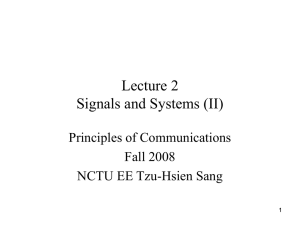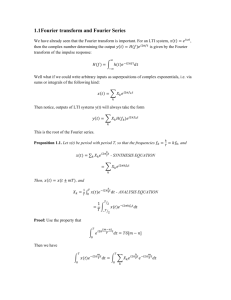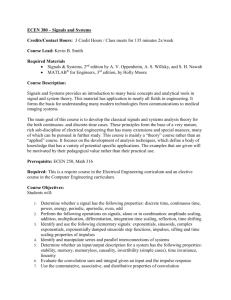Signals and Systems
advertisement
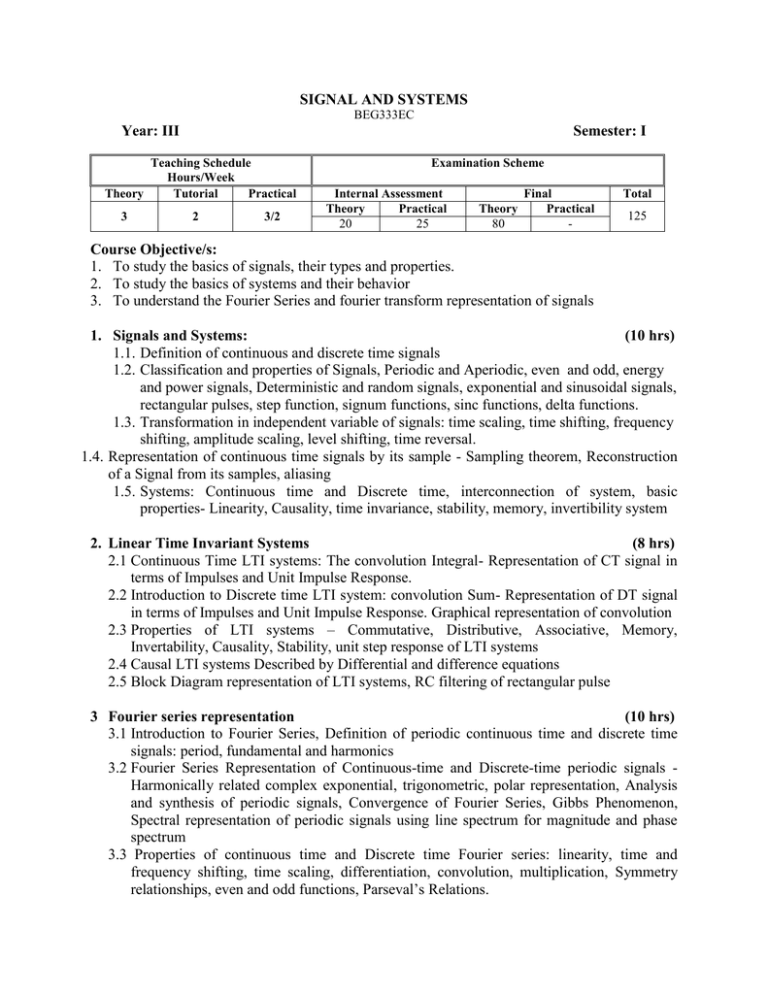
SIGNAL AND SYSTEMS BEG333EC Year: III Semester: I Teaching Schedule Hours/Week Theory Tutorial Practical 3 2 3/2 Examination Scheme Internal Assessment Theory Practical 20 25 Theory 80 Final Practical - Total 125 Course Objective/s: 1. To study the basics of signals, their types and properties. 2. To study the basics of systems and their behavior 3. To understand the Fourier Series and fourier transform representation of signals 1. Signals and Systems: (10 hrs) 1.1. Definition of continuous and discrete time signals 1.2. Classification and properties of Signals, Periodic and Aperiodic, even and odd, energy and power signals, Deterministic and random signals, exponential and sinusoidal signals, rectangular pulses, step function, signum functions, sinc functions, delta functions. 1.3. Transformation in independent variable of signals: time scaling, time shifting, frequency shifting, amplitude scaling, level shifting, time reversal. 1.4. Representation of continuous time signals by its sample - Sampling theorem, Reconstruction of a Signal from its samples, aliasing 1.5. Systems: Continuous time and Discrete time, interconnection of system, basic properties- Linearity, Causality, time invariance, stability, memory, invertibility system 2. Linear Time Invariant Systems (8 hrs) 2.1 Continuous Time LTI systems: The convolution Integral- Representation of CT signal in terms of Impulses and Unit Impulse Response. 2.2 Introduction to Discrete time LTI system: convolution Sum- Representation of DT signal in terms of Impulses and Unit Impulse Response. Graphical representation of convolution 2.3 Properties of LTI systems – Commutative, Distributive, Associative, Memory, Invertability, Causality, Stability, unit step response of LTI systems 2.4 Causal LTI systems Described by Differential and difference equations 2.5 Block Diagram representation of LTI systems, RC filtering of rectangular pulse 3 Fourier series representation (10 hrs) 3.1 Introduction to Fourier Series, Definition of periodic continuous time and discrete time signals: period, fundamental and harmonics 3.2 Fourier Series Representation of Continuous-time and Discrete-time periodic signals Harmonically related complex exponential, trigonometric, polar representation, Analysis and synthesis of periodic signals, Convergence of Fourier Series, Gibbs Phenomenon, Spectral representation of periodic signals using line spectrum for magnitude and phase spectrum 3.3 Properties of continuous time and Discrete time Fourier series: linearity, time and frequency shifting, time scaling, differentiation, convolution, multiplication, Symmetry relationships, even and odd functions, Parseval’s Relations. 3.4 Examples of continuous time filters described by differential equation – RC low pass and RC high pass filter 3.5 Examples of continuous time filters described by differential equation – Recursive and Non-recursive 4 Fourier Transform analysis (8 hrs) 4.1 Definition of the forward and reverse Fourier transforms 4.1 Representation of Aperiodic continuous time and discrete time Fourier Transform, Magnitude, phase, and energy density spectrum, Fourier Transform for periodic signal. 4.2 Fourier transform of the Dirac delta function, the signum function , the step function, the periodic function, and the constant 4.3 Properties of Fourier Transform: Linearity, Periodicity, Duality, Time shifting and scaling property, Convolution property, Modulation property; Parseval’s relations. 5 Energy and Power (6 hrs) 5.1 Cross correlation and auto correlation of functions, properties of correlation function 5.2 Energy density function, Power density function, Parseval’s theorem for periodic signals and finite energy signals, Relation between auto correlation function and energy/power spectral density function. 5.3 Relation between convolution and correlation, Detection of periodic signals in the presence of noise by correlation, Extraction of signal from noise by filtering. 6 Transmission of Signals : (3 hrs) 6.1 Input-Output relationships in the frequency domain, Transfer Function 6.2 Distortionless transmission, ideal low pass filter and impulse response, Step response of ideal low pass filter Laboratory: 1. Plotting of signal and its transformations using MATLAB 2. Convolution, Fourier Series and Fourier Transform simulation in MATLAB. 3. Analysis of signals in Spectrum Analyzer 4. Observation of rectangular pulse through transmission cable References: 1. A. V. Oppenheim and A. S. Willsky, "Signals and Systems", Second Edition, PHI publication 2. A. D. Poularikas and S. Seely, “Signals and Systems”, 2nd Edition, PWS-Kent publishers, 1991. 3. S. Haykin and B.V. Veen, “Signals and Systems”, John Wiley and Sons, Inc. Marking Schemes S. No. Chapter Hours Marks* 1 Signals and Systems 10 18 2 Linear Time Invariant Systems 8 14 3 Fourier series representation 10 18 4 Fourier transform analysis 8 14 5 Energy and Power 6 10 6 Transmission of signals 3 6 * Marks are allocated according to the hours but can be little variation depending on the pattern of the question.
